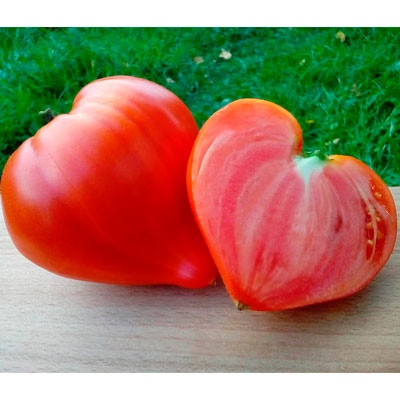
- Authors: Germany
- Name synonyms: Vater Rhein, Fater Rein, Father Rein
- Category: grade
- Growth type: semi-determinant
- Appointment: universal
- Ripening period: mid-season
- Ripening time, days: 95–105
- Growing conditions: for open ground
- Transportability: medium
- Bush size: tall
German quality has already been confirmed by the experience not only of industrial production, but also of selection. This is fully expressed in the Fater Rhine tomato. However, even such an attractive culture needs comprehensive care and attention, taking into account the subtleties and nuances of growing.
Description of the variety
As already mentioned, this tomato was developed by German breeders. It has several synonymous names: Vater Rhein, Fater Rein, Father Rein. It must be emphasized that this is indeed a variety and not a hybrid. It demonstrates the semi-determinant dynamics of bush formation and universal character. Basically it is planted in open ground.
Other features:
- plant height is up to 1.6 m;
- harmonious and compact development of culture;
- low level of foliage;
- long and thin drooping foliage.
The main qualities of the fruit
Basically, the berries of this variety are painted in a simple red color. The appearance of dark spots is not very typical for them. The mass of a single tomato can reach 0.35 kg. Other features:
- the shape of the fetus is a stereotypical "heart";
- there is a well-visible oblong "nose";
- 3.4 or 5 tomatoes in each brush;
- attractive keeping quality.
Taste characteristics
The fruits of Vater Reina are distinguished by their sweet and sour taste. Their pink flesh is quite fleshy. The official description mentions the sugar content of the berries. They contain almost no seeds. The thin, smooth peel has a glossy sheen, and the typical tomato smell emanates from the berry.
Ripening and fruiting
Vater Rhine is classified as a mid-season tomato. Under conditions corresponding to the varietal norm, the harvest will ripen in 95-105 days. Of course, in practice, both meteorological factors and how farmers themselves take care of the plantings play an important role.
Yield
The official description emphasizes the solid yield of the variety. However, no exact figures are provided anywhere. Some breeders mention that up to 5 kg of fruits grow on the bushes. Fee for 1 sq. m while capable of reaching 15 and even 20 kg. It should be noted that the transportability of the crop is moderately high.
The timing of planting seedlings and planting in the ground
It is almost impossible to grow Vater Rhine without seedlings. Sowing seeds in boxes or special containers begins 55-60 days before the tentative transfer into open ground. This transshipment is carried out when the earth is steadily warmed up to 16 degrees. In most regions, the necessary conditions begin during May. That is why it is so important to monitor both the weather and the condition of the seedlings themselves.

Growing tomato seedlings is an extremely important process, because it largely depends on whether the gardener will be able to harvest at all. All aspects must be taken into account, from seedbed preparation to planting in the ground.
Landing scheme
The largest number of tomatoes per 1 sq. m - 4 pieces. Some farmers are limited to 3 plants. The usual system for placing holes is 300x400 mm.

Growing and care
The soil mixture is mainly prepared by hand. For this purpose, uniform volumes of peat, chernozem and sand are used. A certain amount of superphosphate should be added to such a seedling substrate. It will still have to be disinfected in the oven. An alternative is disinfection in heated water vapor or when using a saturated solution of permanganate.
After soaking the seeds in potassium permanganate, they are washed under running water. Seeds are often germinated well in advance. It is recommended to fill the seed containers with moist soil. There should be a gap of about 2 cm between the seeds. These seeds are deepened by 1.5-2 cm.
To make the seedlings germinate better, stretch a plastic wrap over it or put glass. If you provide an air temperature of about +22 degrees, it will take 5-6 days to wait for seedlings to appear. With the emergence of sprouts, the containers should be transferred to a sunny area and ensure the temperature is 15 degrees. A pick on isolated pots is made when 3 or 4 leaves come out. Vater Rhine is required to be illuminated, bringing the duration of illumination to 16 hours.
It is necessary to plant mature seedlings on the southern side of the site. This rule applies to greenhouses and open gardens. Humus is introduced into the ground before planting. The optimum hole depth is 20 cm. Observance of crop rotation is mandatory.
Important nuances of cultivation:
- when formed in 1 stem, you can get fruits weighing up to 1 kg (although usually the variety is formed in 2 or 3 trunks);
- the strength of the bushes is ensured by hilling: they resort to it 2-3 times during the growing season;
- the garter is renewed every 2 or 3 weeks;
- Watering Vater Rhine plants should be 1-2 times a week, using 1 liter of rain or settled water.
The first feeding includes mineral and organic components. In subsequent times, exclusively mineral substances are used. A good choice is either Kemira Lux or Mortar. Vater Rein is little affected by viral ailments. However, apical rot and late blight are still dangerous for him.




A plant needs different micronutrients at each stage of growth. All fertilizers can be divided into two groups: mineral and organic. Folk remedies are often used: iodine, yeast, bird droppings, eggshells.
It is important to observe the rate and period of feeding. This also applies to folk remedies and organic fertilizers.



























































































